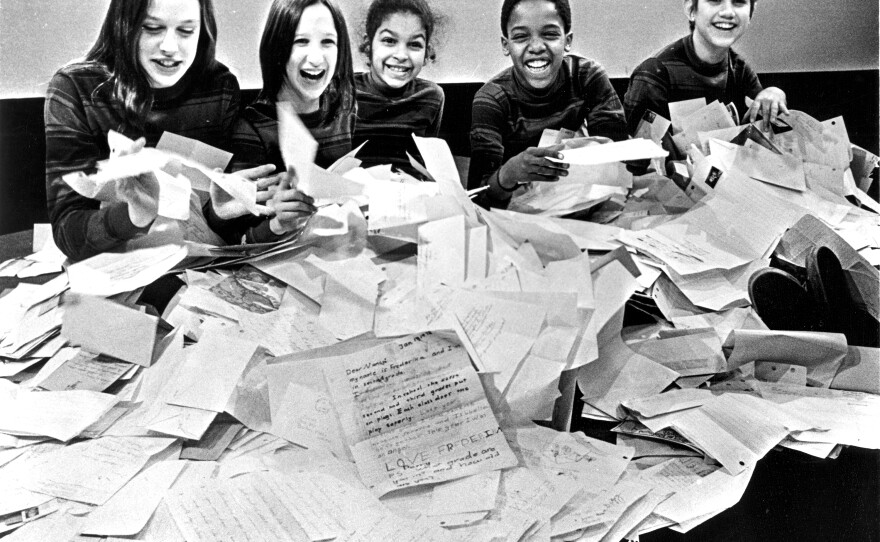For pre-teens watching TV in the early 1970s, the opening to Zoom was captivating with seven, charismatic, barefoot kids in rugby shirts running, jumping, dancing and singing on a bare stage. They beckoned young viewers with the lyrics, "Come on and zoom, zoom, zoom-a zoom. You gotta zoom, zoom, zoom-a zoom."
Zoom was created during a period of experimentation in educational television. Think Sesame Street and The Electric Company. Zoom was partly created to help model interpersonal relationships. Its legacy, however, may have been making a Boston zip code famous.
To celebrate Zoom's 50th anniversary, the American Archive of Public Broadcasting has made more than 100 episodes available to stream online for the first time. GBH, where Zoom was produced, has a virtual event featuring a conversation with creator and producer Christopher Sarson; David Kamp, journalist and author of Sunny Days: The Children's Television Revolution That Changed America, and comments from original cast members or "Zoomers" as they're called.
"It was seven kids having fun and just being children," remembers original Zoomer Nancy Walker. She tells NPR the producers "allowed us to be inquisitive." After Zoom she went on to do some acting and then got into television production. Walker credits the producers, composer Newton Wayland and choreographer Billy Wilson with bringing "out the best in us."
Zoom's focus was on kids' lives
Walker's fellow Zoomer Joseph Shrand says the experience was "exhilarating" and "the best thing ever." Now Dr. Shrand is a psychiatrist and author.
Christopher Sarson tells NPR two forces influenced his vision for Zoom. While watching TV with his children in the early 1970s, he found shows like The Partridge Family "were all false. None of them was real life." He also observed how his children behaved with peers they didn't know. They were eager to make friends but afraid of being laughed at. Sarson set out to make a program that would deal "with personalities ... and the interaction of people rather than with any particular storyline."
On Zoom, those interactions played out in both scripted and improvised segments. WGBH once compared it to the sketch comedy show Rowan & Martin's Laugh In. The cast joked around, sang and danced, played games, spoke Ubbi Dubbi and demonstrated how to make crafts.
Zoom encouraged creativity and made a zip code famous
At the end of Zoom episodes, another catchy song had the cast encourage viewers to send them letters, ideas, and original writings and artwork. They belted out the zip code, "0-2-1-3-4." Tens of thousands of kids took them up on the offer. Sarson says they responded to all of them. "We introduced a new word which was 'say-zee,' which was 'self-addressed stamped envelope,' because we couldn't afford the postage. It became bigger than the production," he remembers.
Some of those letters are in a special online exhibition on the AAPB website called ZOOM (1972-1978): Children's Community and Public Television in the 1970s, created by Leslie Paris, an associate professor of history at the University of British Columbia in Vancouver, Canada.
Paris, herself a fan of the show when she was a little girl, was struck by "how connected kids felt to the show" as well as the individual cast members. According to Paris, it was the adults who were reading those letters, not the young Zoomers. She says that was intentional so that "young cast members wouldn't feel that they were anything other than ordinary kids."

Paris believes Zoom was "quietly influential in the sense that it encouraged children to be creative, to think that what they were doing was important ... that their ideas had value ... and part of why it's remained a very nostalgic show for children of the 1970s."
Dr. Shrand says, "Zoom has been an enormous foundation for everything I'm doing now as a child psychiatrist." He credits the producers with bringing kids from different walks of life together. "We became friends very quickly," he says. Shrand believes those bonds were apparent to viewers and helped model that "you can be who you are in a group of people who respect you and value you, and that allows you to trust. And that trust allows you to explore .... who you are."
Copyright 2023 NPR. To see more, visit https://www.npr.org. 9(MDAzMjM2NDYzMDEyMzc1Njk5NjAxNzY3OQ001))







